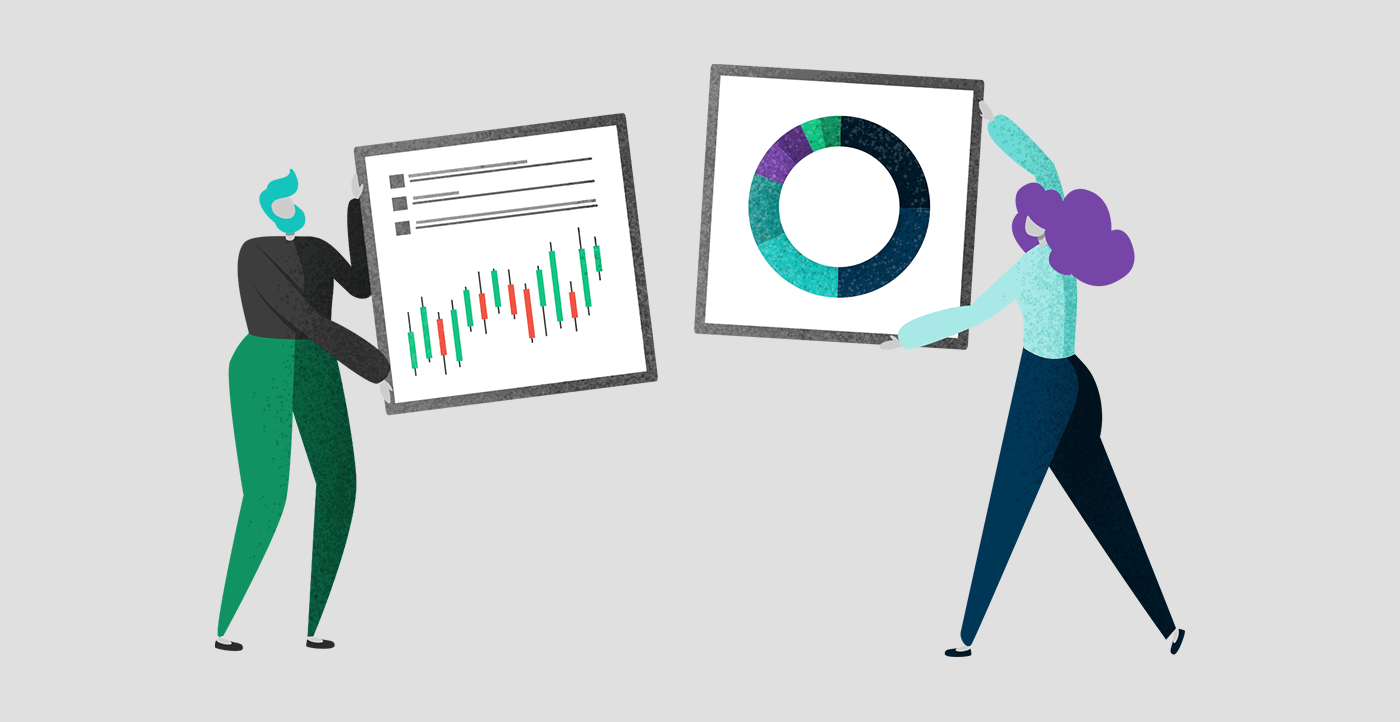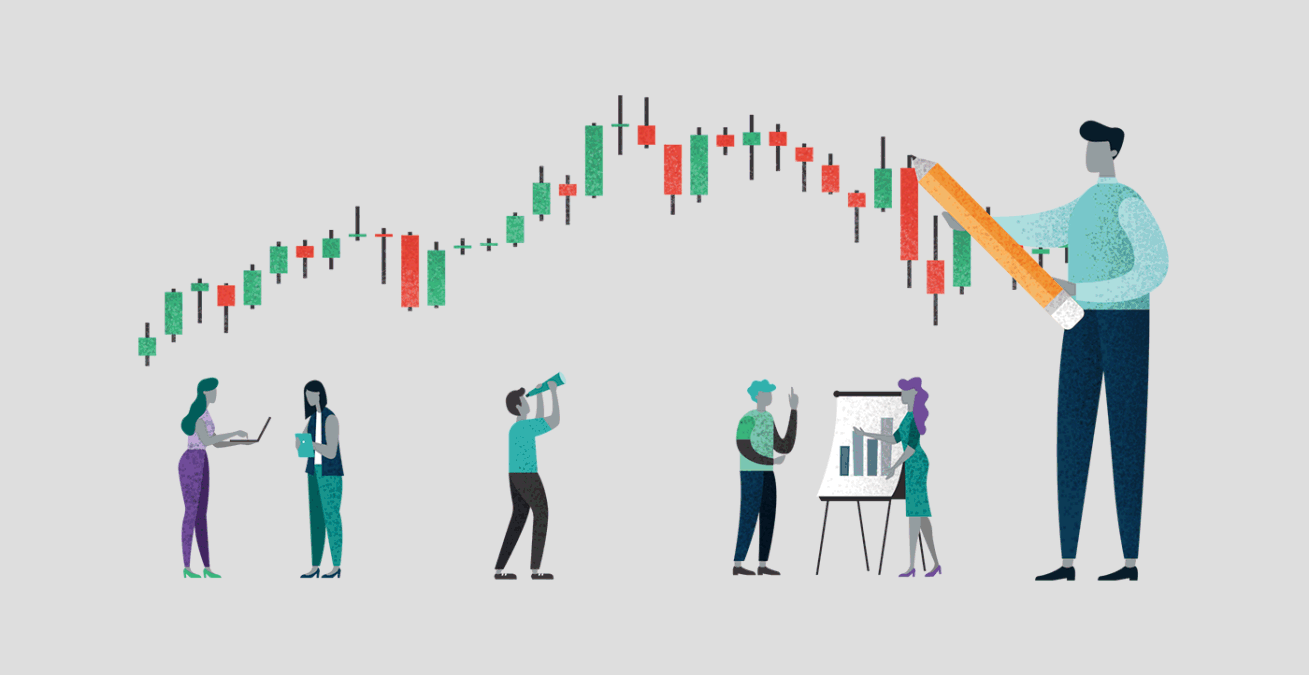Trading vs. investing: 6 things you need to know

What do millionaire hedge fund managers, white- and blue-collar workers, Jeff Bezos, kids selling lemonade on your neighborhood street corner, and nearly every other American have in common?
They’re all motivated in part by the desire to make money.
Building wealth is a near-universal objective in our society. After all, we need money for everything from putting food on the table to ensuring comfortable retirement years to (in the case of Jeff Bezos) purchasing a $65 million private jet[1].
The approach we take to pursue that goal, however, is where human beings differ.
A majority of U.S. adults opt to grow wealth in part through participation in the stock market[2]. But even those who attempt to profit from the purchase and sale of securities can have very different strategies and goals for doing so. Most fall into one of two categories: traders or investors.
So what’s the difference between the two? And how do you choose the best approach for your unique financial needs?

Trading
Objective: Traders generally act in the short-term in pursuit of more immediate gains. In other words, their behavior is generally the exact opposite of buy-and-hold. As a result, they tend to seek gains of about 10 percent or more each month[3]. The caveat? Pursuing higher, more expedited returns may require the assumption of additional risk. Of course, for some traders, risk is just part of the fun[4].
Holding period: Time frames for buying and selling securities can range anywhere from minutes to months, with traders adopting one of several styles depending on the time frame in which they aim to open and close positions within the market. For example, day traders buy and sell securities (as their name implies) within the same day, rather than holding positions overnight. Swing traders, on the other hand, tend to hold positions from days to weeks.
Time commitment: Trading style tends to dictate time commitment, though trading, by nature, requires more active participation than buy-and-hold investing. While investments may be automated, trading tends to be a predominantly manual process. For day traders, purchasing and selling securities (and all the research that accompanies it) requires several hours each day, ranging from about 15 to 40 each week[3], which is why day trading itself can be a full-time job. Swing trading, on the other hand, demands considerably less time than day trading, though still requiring significantly higher levels of participation than buy-and-hold investing.
Costs: Trading can be expensive. In fact, day traders must legally maintain an account balance of at least $25,000 to trade stocks in the U.S. While traders buying and selling stocks over the course of weeks or months aren’t subject to minimum capital requirements, they’ll still need to weigh position size, account risk, and trade risk[5] to gauge how much they’ll need to get started.
For traders with less capital, however, commissions and fees can quickly negate small gains. A general rule of thumb is to risk no more than 2 percent of account size on a single trade, and preferably closer to 1 percent. For swing traders, risking less than $100 on a single trade, however, can result in fees and commissions ultimately canceling out (or completely obliterating) returns[5]. Therefore, swing traders may need $10,000 or more to begin trading.
Mindset: Traders tend to view the market as a collection of ticker symbols, tracking market news and reviewing financial reports in an attempt to home in on micro-opportunities to beat the market. While investors study market fundamentals to identify opportunities for long-term business growth, traders often hope to make a profit by targeting smaller upswings and downswings in the market, seeking opportunity in price fluctuations and volatility.
For this reason, stock trading tends to attract individuals with a stomach for risk. It also requires acute and constant attention to detail in order to identify a small mispricing or inefficiency in the market that could result in returns. And because of the high level of involvement inherent to trading, it can often be a more intense, emotional process than buy-and-hold investing.
How to succeed: In order to earn significant returns, traders often require significant capital from the start. From there, they must correctly time the market again and again… and again. While the instant gratification may act as a magnet for those looking to make a quick buck, the reality is that 80 percent of people who trade end up losing money, and a meager 1 percent do it well enough to be “predictably profitable[6].”

Investing
Objective: Investors aim to build wealth for the long-term. And by long-term, we mean anywhere from a couple years to decades on end. This is typically done by evaluating market fundamentals and assessing value to choose stocks or other securities that will perform will over time. As a result, investors strive to ride out short-term dips in the market to increase their net worth as markets move up and to the right over time, despite occasional downturns[7].
Because investors target sustained growth, they tend to aim for 8-15 percent annual growth, though increases or decreases in risk may expand that range in either direction. Investors may often profit off more than the purchase and sale of securities, as well, benefiting from interest, compounding, dividends, and stock splits over the years or decades of holding securities[8].
Holding period: Investors hold securities for years or decades. Warren Buffet, one of the greatest investors of all time, bought $1 billion in Coca-Cola in 1988 and still owns the stock today, 30 years later[9]. Holding assets for decades can be ideal for financial goals like preparing for retirement, while investors looking to build wealth for nearer-term goals, like purchasing a home, may have a horizon closer to 3-5 years.
Time commitment: Buy-and-hold investing will likely involve a significant time commitment… but only at first. Much of the legwork is done upfront to research market fundamentals, consider price and valuation, and assess potential for long-term growth. It may take a while to comb through all the necessary metrics, management forecasts, etc., but once you’ve chosen a security, the time requirements take a sharp dip.
Costs: Because investors tend to buy and hold securities for long periods of time and engage in fewer trades, they can generally expect lower transaction costs and taxes than traders. From there, costs can vary radically by investment vehicle and between brokerages — choosing to invest in mutual funds, for example, will likely result in higher costs than stocks or commission-free ETFs. As a result, investors will want to keep a close eye on fees and commissions to ensure these costs don’t completely eat away at overall returns. Opting for a free platform, therefore, allows investors to maximize returns and compound interest over time.
Mindset: Where traders see ticker symbols, investors see a business. And the most successful investors truly view holding a stock as owning a portion of the business. Stock ownership for investors, therefore, requires a more measured approach than trading. Investors must do their due diligence to gauge value before purchasing, researching price-to-earnings ratios, revenue growth, balance sheets, management forecasts, and so on.
The true test, however, often comes in the form of day-to-day fluctuations. Unlike traders, who often act in response to miniscule market events, investors often profit off their ability not to react at all. As a result, the most successful investors act rationally rather than emotionally, and resist the urge to panic when markets and securities dip. After all, if you feel compelled to react to every blip in stock price, you’re acting more like a trader than an investor, and may be missing out on significant long-term growth.
How to succeed: Learn how to choose the right stocks, do your research, and come up with a long-term plan you can stick to. While no trade or investment is a guarantee, knowing what you own and why you own it will help you resist the urge to make impromptu decisions and ride out any downturns. Couple that with a diversified portfolio to smooth out unnecessary risk and you’ll be much better positioned for long-term growth.
You’ll also want to take time to research the best tool for your investing needs. That’s where we come in.
M1 embodies the best attributes of long-term investing to act as the ultimate wealth building tool. Our totally free investing platform allows you to choose your own investments, so your portfolio can be completely personalized to your unique financial goals. Our intelligent automation even ensures money from every deposit flows into your portfolio exactly how you want. Plus, we use fractional shares so every penny goes to work in your portfolio. Top it all off by setting an investing schedule, and you’ll never miss an opportunity to invest in your future again.

- CNBC
- Gallup
- The Balance
- Nerd Wallet
- Vantage Point Trading
- Business Insider
- Macro Trends
- Investopedia
- Investopedia
- Categories
- Invest




